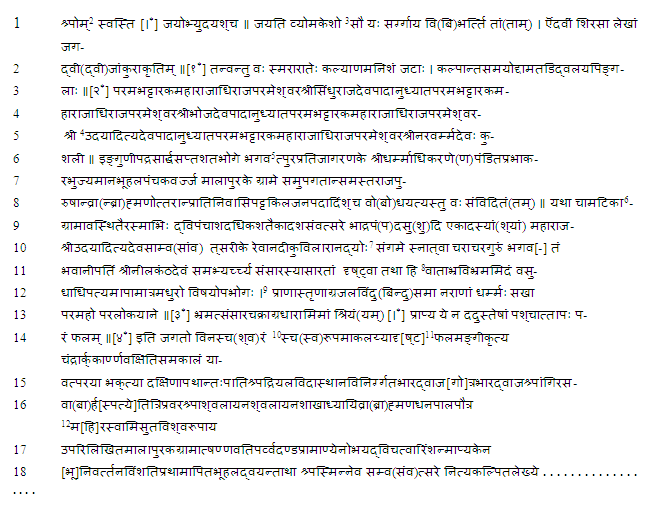| |
North
Indian Inscriptions |
| |
|
|
|
INSCRIPTIONS OF THE PARAMARAS OF MALWA
BHOJPUR IMAGE INSCRIPTION OF THE TIME OF NARAVARMAN
TEXT[1]
[Metres : Verses 1-2 and 4 Anushṭubh; v. 3 Vasantatilakā ].

No. 32 ; PLATE XXXIV B
BHOJPUR IMAGE INSCRIPTION OF THE TIME OF NARAVARMAN
[Vikrama] Year 1157
...THIS inscription is engraved on the pedestal of an image of the Jaina Tīrthaṅkara
Pārśvanātha in an old Jaina temple at the village of Bhōjpur[13]
in the Goharganj tālukā
of the Raisen District in Madhya Pradesh. It was discovered by Dr. D. C. Sircar, then
_________________________________________________
[1] From the original plate.
[2] Expressed by a symbol.
[3] The palatal sibilant, wherever it occurs in this inscription, has its loop so curved as to appear as the midstroke of the dental, and the distinction between the two letters can be noted only in a close study.
[4] Sandhi has not been performed here and also in 1. 10 below, where the expression again occurs.
[5] Here and in some other cases below, which have not been pointed out separately, the letter व् is engraved
as च्.
[6] The first letter of this name is somewhat like व् or भ् or त् : but I take it as च. The reading is
doubtful. Near the confluence of the two rivers there was a village of the name of Chamaradaha, suggesting its identification with Chāmaṭikā.
[7] Better read रेवाकुविलारानद्यो:.
[8] This verse and the following one are put by way of a parenthesis and the sentence is continued with
इति जगतः in 1. 14.
[9] As the vacant space shows, this daṇḍa was originally engraved but has disappeared in the process of
cutting the plate. The त्र in मात्र was originally engraved with three horizontal strokes and later on
one of them was rubbed off.
[10] As stated above in n. 6. this and the preceding व् look like च्.
[11] The slanting bar of the member of the conjunct consonant is not engraved and thus it looks like प्
[12] Sandhi is not performed in all the instances in this and the preceding lines. though compulsory; and the
top-stroke showing the mātrā of pau is so engraved as to appear as the sign of the long medial ī.
For another inscription from the same place, see above, No. 17.
|
\D7
![]()
|








